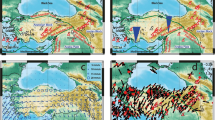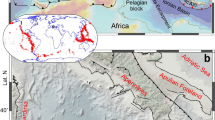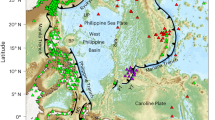Abstract
The most likely cause of seismic anisotropy in the Earth’s upper mantle is the lattice preferred orientation of anisotropic minerals such as olivine1,2. Its presence reflects dynamic processes related to formation of the lithosphere as well as to present-day tectonic motions. A powerful tool for detecting and characterizing upper-mantle anisotropy is the analysis of shear-wave splitting measurements. Because of the poor vertical resolution afforded by this type of data, however, it has remained controversial whether the splitting has a lithospheric origin that is ‘frozen-in’ at the time of formation of the craton3, or whether the anisotropy originates primarily in the asthenosphere, and is induced by shear owing to present-day absolute plate motions4. In addition, predictions from surface-wave-derived models are largely incompatible with shear-wave splitting observations5,6. Here we show that this disagreement can be resolved by simultaneously inverting surface waveforms and shear-wave splitting data. We present evidence for the presence of two layers of anisotropy with different fast-axis orientations in the cratonic part of the North American upper mantle. At asthenospheric depths (200–400 km) the fast axis is sub-parallel to the absolute plate motion, confirming the presence of shear related to current tectonic processes, whereas in the lithosphere (80–200 km), the orientation is significantly more northerly. In the western, tectonically active, part of North America, the fast-axis direction is consistent with the absolute plate motion throughout the depth range considered, in agreement with a much thinner lithosphere.
This is a preview of subscription content, access via your institution
Access options
Subscribe to this journal
Receive 51 print issues and online access
$199.00 per year
only $3.90 per issue
Buy this article
- Purchase on Springer Link
- Instant access to full article PDF
Prices may be subject to local taxes which are calculated during checkout




Similar content being viewed by others
References
Nicolas, A. & Christensen, N. I. in Composition, Structure and Dynamics of the Lithosphere/Asthenosphere System (eds Fuchs, K. & Froidevaux, C.) Geodyn. Ser. 16, 111–123 (AGU, Washington DC, 1987)
Babuška, V. & Cara, M. Seismic Anisotropy in the Earth (Kluwer Academic, Dordrecht, 1991)
Silver, P. G. Seismic anisotropy beneath continents: probing the depth of geology. Annu. Rev. Earth Planet. Sci. 24, 385–421 (1996)
Vinnik, L. P., Makeyeva, L. I., Milev, A. Y. & Usenko, A. Y. Global patterns of azimuthal anisotropy and deformations in the continental mantle. Geophys. J. Int. 111, 433–447 (1992)
Montagner, J.-P., Griot-Pommera, D.-A. & Lavé, J. How to relate body wave and surface wave anisotropy? J. Geophys. Res. 105, 19015–19027 (2000)
Debayle, E., Kennett, B. L. N. & Priestley, K. Global azimuthal seismic anisotropy and the unique plate-motion deformation of Australia. Science 433, 509–512 (2005)
Vinnik, L. P., Kosarev, G. L. & Makeyeva, L. I. Anisotropy of the lithosphere from the observations of SKS and SKKS. Proc. Acad. Sci. USSR [in Russian]. 278, 1335–1339 (1984)
Montagner, J.-P. Upper mantle structure: global isotropic and anisotropic elastic tomography. Treat. Geophys. 1, (in the press).
Gung, Y., Panning, M. & Romanowicz, B. Global anisotropy and the thickness of continents. Nature 422, 707–711 (2003)
Marone, F., Gung, Y. & Romanowicz, B. 3D radial anisotropic structure of the North American upper mantle from inversion of surface waveform data. Geophys. J. Int. (submitted).
Gripp, A. E. & Gordon, R. G. Young tracks of hotspots and current plate velocities. Geophys. J. Int. 150, 321–361 (2002)
Smith, D. B., Ritzwoller, M. H. & Shapiro, N. M. Stratification of anisotropy in the Pacific upper mantle. J. Geophys. Res. 109 B11309 doi: 10.1029/2004JB003200 (2004)
Tanimoto, T. & Anderson, D. L. Lateral heterogeneity and azimuthal anisotropy of the upper mantle: Love and Rayleigh waves 100–250 s. J. Geophys. Res. 90, 1842–1858 (1985)
Montagner, J.-P. & Tanimoto, T. Global upper mantle tomography of seismic velocities and anisotropies. J. Geophys. Res. 96, 20337–20351 (1991)
Simons, F., Van der Hilst, R., Montagner, J.-P. & Zielhuis, A. Multimode Rayleigh wave inversion for heterogeneity and azimuthal anisotropy of the Australian upper mantle. Geophys. J. Int. 151, 738–754 (2002)
Fouch, M. J., Fischer, K. M., Parmentier, E. M., Wysession, M. E. & Clarke, T. J. Shear wave splitting, continental keels, and pattern of mantle flow. J. Geophys. Res. 105, 6255–6275 (2000)
Rondenay, S., Bostock, M. G., Hearn, T. M., White, D. J. & Ellis, R. M. Lithospheric assembly and modification of the SE Canadian Shield: Abitibi-Grenville teleseismic experiment. J. Geophys. Res. 105, 13735–13754 (2000)
Eaton, D., Frederiksen, A. & Miong, S.-K. Shear-wave splitting observations in the lower Great Lakes region: Evidence for regional anisotropic domains and keel-modified asthenospheric flow. Geophys. J. Lett. 31 L07610 doi: 10.1029/2004GL019438 (2004)
Babuška, V., Montagner, J.-P., Plomerová, J. & Girardin, N. Age-dependent large-scale fabric of the mantle lithosphere as derived from surface-wave velocity anisotropy. Pure Appl. Geophys. 151, 257–280 (1998)
Kay, I. et al. Shear wave splitting observations in the Archean Craton of Western Superior. Geophys. Res. Lett. 26, 2669–2672 (1999)
Levin, V., Menke, W. & Park, J. No regional anisotropic domains in the northeastern U.S. Appalachians. J. Geophys. Res. 105, 19029–19042 (2000)
Bokelmann, G. H. R. & Silver, P. G. Mantle variation within the Canadian Shield: travel times from the portable broadband Archean-Proterozoic transect 1989. J. Geophys. Res. 105, 579–605 (2000)
Currie, C. A., Cassidy, J. F., Hyndman, R. D. & Bostock, M. G. Shear wave anisotropy beneath the Cascadia subduction zone and western North American craton. Geophys. J. Int. 157, 341–353 (2004)
Gaherty, J. B. A surface wave analysis of seismic anisotropy beneath eastern North America. Geophys. J. Int. 158, 1053–1066 (2004)
Li, X.-D. & Romanowicz, B. Comparison of global waveform inversions with and without considering cross branch coupling. Geophys. J. Int. 121, 695–709 (1995)
Smith, M. L. & Dahlen, F. A. The azimuthal dependence of Love and Rayleigh waves propagation in a slightly anisotropic medium. J. Geophys. Res. 78, 3321–3333 (1973); correction. 80, 1923 (1975)
Romanowicz, B. & Snieder, R. A new formalism for the effect of lateral heterogeneity on normal modes and surface waves, II. General anisotropic perturbations. Geophys. J. R. Astron. Soc. 93, 91–99 (1988)
Larsen, E. W. F., Tromp, J. & Ekström, G. Effects of slight anisotropy on surface waves. Geophys. J. Int. 132, 654–666 (1998)
Montagner, J.-P. & Nataf, H.-C. A simple method for inverting the azimuthal anisotropy of surface waves. J. Geophys. Res. 91, 511–520 (1986)
Love, A. E. H. A Treatise on the Mathematical Theory of Elasticity (Cambridge Univ. Press, Cambridge, 1927)
Montagner, J.-P. & Anderson, D. L. Petrological constraints on seismic anisotropy. Phys. Earth Planet. Inter. 54, 82–105 (1989)
Silver, P. G. & Savage, M. K. The interpretation of shear-wave splitting parameters in the presence of two anisotropic layers. Geophys. J. Int. 119, 949–963 (1994)
Wolfe, J. W. & Silver, P. G. Seismic anisotropy of oceanic upper mantle: Shear wave splitting methodologies and observations. J. Geophys. Res. 103, 749–771 (1998)
Rümpker, G. & Silver, P. G. Apparent shear-wave splitting parameters in the presence of vertically varying anisotropy. Geophys. J. Int. 135, 790–800 (1998)
Panning, M. P. & Romanowicz, B. A three dimensional radially anisotropic model of shear velocity in the whole mantle. Geophys. J. Int. 167, 361–379 (2006)
Mooney, W. D., Laske, G. & Masters, T. G. CRUST5.1: a global crustal model at 5°x 5°. J. Geophys. Res. 103, 727–747 (1998)
Mégnin, C. & Romanowicz, B. The 3D shear velocity structure of the mantle from the inversion of body, surface and higher mode waveforms. Geophys. J. Int. 143, 709–728 (2000)
Tarantola, A. & Valette, B. Generalized nonlinear inverse problems solved using the least squares criterion. Rev. Geophys. Space Phys. 20, 219–232 (1982)
Wang, Z. & Dahlen, F. A. Spherical-spline parameterization of three-dimensional Earth models. Geophys. Res. Lett. 22, 3099–3102 (1995)
Acknowledgements
We thank IRIS-DMC, the Geological Survey of Canada and the Northern California Earthquake Data Center for distributing the data used in this study. This work was partially supported through an NSF grant and a grant from the Stefano Franscini Foundation (Switzerland).
Author information
Authors and Affiliations
Corresponding author
Ethics declarations
Competing interests
Reprints and permissions information is available at www.nature.com/reprints. The authors declare no competing financial interests.
Supplementary information
Supplementary Information
This file contains Supplementary Data, Supplementary Methods, Supplementary Figures 1-8 with Legends, Supplementary Table 1 and additional references. (PDF 2555 kb)
Rights and permissions
About this article
Cite this article
Marone, F., Romanowicz, B. The depth distribution of azimuthal anisotropy in the continental upper mantle. Nature 447, 198–201 (2007). https://doi.org/10.1038/nature05742
Received:
Accepted:
Issue Date:
DOI: https://doi.org/10.1038/nature05742
This article is cited by
-
Earth’s gradients as the engine of plate tectonics and earthquakes
La Rivista del Nuovo Cimento (2022)
-
Seismic evidence for subduction-induced mantle flows underneath Middle America
Nature Communications (2020)
-
Upper mantle anisotropy and crust-mantle deformation pattern beneath the Chinese mainland
Science China Earth Sciences (2014)
-
Complex and variable crustal and uppermost mantle seismic anisotropy in the western United States
Nature Geoscience (2011)
-
Complex layered deformation within the Aegean crust and mantle revealed by seismic anisotropy
Nature Geoscience (2011)
Comments
By submitting a comment you agree to abide by our Terms and Community Guidelines. If you find something abusive or that does not comply with our terms or guidelines please flag it as inappropriate.



